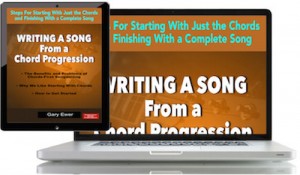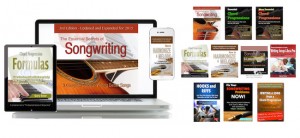It’s common to come up with a chorus before you come up with a verse. That’s because the chorus is the section with the hook, the catchy bit that you hope brings your audience back time and time again. They’re repetitive and of relatively simple construction, so they’re often easier than other sections to write.
It’s also common to get stuck in your songwriting process once you’ve written that chorus. It’s sometimes hard to imagine what music might lead naturally to a chorus. It’s a bit like seeing a beautiful field, and then imagining what the roads leading up to it might look like.
Perhaps you’re in that situation right now: you’ve got a chorus, and now you’re trying to create a verse that leads naturally and successfully to the chorus. You want a verse that, as we often say, begs for the chorus.
 “Writing a Song From a Chord Progression” is an eBook that shows you the best way to develop a songwriting process that starts with chords. It’s part of “The Essential Secrets of Songwriting” 10-eBook Deluxe Bundle. Get today’s special deal.
“Writing a Song From a Chord Progression” is an eBook that shows you the best way to develop a songwriting process that starts with chords. It’s part of “The Essential Secrets of Songwriting” 10-eBook Deluxe Bundle. Get today’s special deal.
Without knowing what your chorus actually sounds like, I think I can make some assumptions based on what successful choruses usually do:
- Your chorus melody is likely fairly high in pitch.
- Your chorus presents a line of lyric that easily stands as the song’s title.
- Your chorus probably uses a simple but tonally strong chord progression.
- Your chorus uses rhythms that are simple and strong.
To create your verse, you’re probably trying to improvise something, and I think that’s a good way to generate ideas. For any one chorus, there are many possible verses that might do the trick.
As you try to generate ideas for your verse, keep the following in mind:
- Improvise low-pitched melodies. Verse melodies tend to be lower than chorus melodies. The best partner for your chorus is probably going to be lower in pitch than the verse.
- Try “opposite ideas” to create a verse melody. Let’s say that your chorus makes use of a rising melodic idea (“Pen-ny Lane”, “in my ears”, etc.) Create a verse melody that uses lots of downward-moving shapes (“…there is a barber showing photographs…”)
- Create lyrics that require the chorus lyric as a kind of answer. If the main point of your chorus is to say how great your life is, use the verse to describe situations, people and circumstances that make it that way. Doing so means that your chorus has a purpose.
- Create verse progressions that explore chords that stray away from what the chorus offers. If your chorus is a standard I-vi-IV-V-I progression (C-Am-F-G-C), see what you can do to explore the minor side of C major – maybe something like Am-F-G-Dm-Am, or Am-G-Am-Dm-Am. Or simply allow your C major progression to wander a bit more than what you’d typically find in a chorus, something like: C G/B Gm/Bb A7 Dm Eb Bb F |C…
- Use melodic rhythms in your verse that are quicker and possibly more rhythmically syncopated than what you’ve used in your chorus. I think “Stronger (What Doesn’t Kill You)” (Jörgen Elofsson, David Gamson, Greg Kurstin, and Ali Tamposi), is a great recent example of this concept. The verse melody/lyric allows for quick, syncopated rhythms, but the chorus rhythms simplify and become very grounded and locked in.
Trying to come up with a verse can take a while. Make a few attempts, and if it doesn’t work right away, put the song aside for a week or so, take it out and then try again. It’s the kind of thing that can raise your frustration levels if you let it.
As you work to get a verse that partners well with your chorus, use that time to get a new song started. Having several songs on the go can help reduce the anxiety that comes from finishing touches taking longer than you’d like.
 Written by Gary Ewer. Follow Gary on Twitter.
Written by Gary Ewer. Follow Gary on Twitter.
 If you’re looking for one set of eBooks that will cover everything you need to know about writing songs –creating melodies, lyrics, chord progressions, and more — “The Essential Secrets of Songwriting” 10-eBook Deluxe Bundle is what you’re looking for. It always comes with a SPECIAL DEAL.
If you’re looking for one set of eBooks that will cover everything you need to know about writing songs –creating melodies, lyrics, chord progressions, and more — “The Essential Secrets of Songwriting” 10-eBook Deluxe Bundle is what you’re looking for. It always comes with a SPECIAL DEAL.











didn’t understand point 5.
Which song are you talking about in point 2?
The song referenced in Point 2 is Lennon & McCartney’s “Penny Lane”
-G
I usually write my verse before chorus and get stuck with my chorus.
Pls I need serious help right now on how to make it right
Many pro writers will not even start a song until they think of a title
So it stands to reason that you are going to use that title in your CHORUS
however even that title can change during the writing process, in fact many
things can change like the Tempo and the B P M Its good to have that songs
title because an old adage states point every line at your title
but nothing should be set in concrete ;
In fact as you improve as a writer of songs you can often do go back
to an earlier song you wrote that was never seriously pitched and change a
few phrases, I often do that Re Write and Re Write thats part of writing
consistently good to very good songs in my humble opinion
Pingback: Synthesizers and Song Stucture: Producing "Please Don't Come Home", Day 7 · Remote God Music
Excellent advice that’s helping me push through the current songwriting hump. Got an AWESOME chorus but I’m drawing blanks (or one weak idea after another) for the verse.
The key insights for me from this article were A) analyze the melody of the Chorus and “do the opposite shape” for the Verse. and B) words that the Chorus will “answer.”
I’m still stuck, but I know if I’m patient I’ll get this song figured out, and then other people can hear this AMAZING chorus and dance their asses off 🙂
Pingback: Writing a Verse Once You’ve Got the Chorus - The Hit Songwriting Formula | The Hit Songwriting Formula